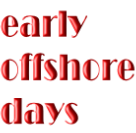© 2014-

Early Offshore Days (2)
The first true offshore commercial broadcaster
It took some years before technical developments were sufficiently advanced for any further attempt to be made to launch a radio station from on board a ship. When it did happen the development came about in an unlikely location.
Offshore radio is usually thought of in the context of providing an alternative to established state monopoly broa dcasting systems, but the world's first true commercial offshore station was, surprisingly, located off the west coast of the USA during the early 1930s. The station -
dcasting systems, but the world's first true commercial offshore station was, surprisingly, located off the west coast of the USA during the early 1930s. The station -
A full history of this station can be found in the America Gallery.
Other early offshore broadcasting ventures
Although a number of other ship-
Propaganda station against Hitler
A propaganda offshore ra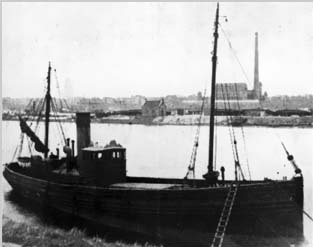 dio station operated between January and April 1938 from a small ship -
dio station operated between January and April 1938 from a small ship -
The Faithful Friend was a British fishing trawler, registered in Lowestoft, Suffolk and had been used from 1915 to 1919, by the British Navy to lay nets for the defence of ports during the First World War.The main person behind the station was Carl Spiecker, who had headed a special unit of the German government for the 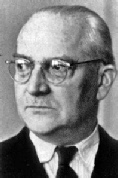 fight against National Socialism, but after the Nazis seized power in January 1933, he was dismissed for "political unreliability." Spiecker fled abroad and while exiled in France, together with other liberal-
fight against National Socialism, but after the Nazis seized power in January 1933, he was dismissed for "political unreliability." Spiecker fled abroad and while exiled in France, together with other liberal-
From his exile in Paris Spiecker published a series of "Freedom Letters", then turned his attention to the use of radio to further the aims of the DPP. In great secrecy (with help from British and Dutch technicians) the Faithful Friend was acquired and fitted with radio equipment.
Although he was the organisational and editorial director of the radio station, Carl Spiecker was not himself on board the Faithful Friend -
Jakob A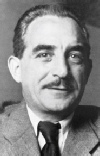 ltmaier came from a Jewish family in Flörsheim, Hesse and was seriously wounded as a front-
ltmaier came from a Jewish family in Flörsheim, Hesse and was seriously wounded as a front-
Ernst Langendorf came from Rottweil im Taunus and was the son of an architect. He had already worked in the 1920s as a reporter for the Social Democ ratic newspaper Volksstimme (Frankfurt) and later at the SPD newspaper Hamburger Echo until the paper was banned by the National Socialists. He also emigrated to France in April 1933 and changed his first name to Ernest.
ratic newspaper Volksstimme (Frankfurt) and later at the SPD newspaper Hamburger Echo until the paper was banned by the National Socialists. He also emigrated to France in April 1933 and changed his first name to Ernest.
As well as the broadcasters there were two radio technicians from the Dutch broadcaster VARA (one of them was D.J. Fruin, the chief engineer of VARA.) on board Faithful Friend who took it in turns to maintain the technical equipment.
The station broadcast on a short wave frequency of 7842 kHz (38.26m) with a transmitter power of less than 5 Kw. Its target audience was listeners in Holland and inside Germany itself, where it was hoped to stimulate an anti-
Broadcasts normally took place from 7.30 to 8.00pm and from 10.00 to 10.30pm and, if weather conditions allowed, the programmes were repeated several times a night. However, broadcasts sometimes didn't take place in the event of stormy weather when the ship was unable to leave port.
Programmes were intended to provide an uncensored and objective source of news and commentary on events taking place at the time in Nazi Germany. They consisted of world news, but with an emphasis on German stories, followed by political commentary and an international press review, as well as calls for resistance against the Hitler regime. The aim was to educate the German population about the "true nature of the Nazi Group" and its war intentions.
Broadcasts continued for about three months from January to early April 1938, when conditions in Paris made it more difficult for Spiecker to continue operating. His contact at the Ministry of Foreign Affairs in Paris advised him to disappear from French national waters as far away as possible until the situation became clearer.
The crew of the Faithful Friend accepted Carl Spiecker's recommendation and sailed from the French port of Cherbourg to the Dutch city of IJmuiden on 12th April. 1938 Two days later the Faithful Friend left the Dutch port, the radio equipment was removed and placed in a warehouse in Boulogne-
City of Panama
Faithful Friend
Photo: Martin van der Ven / Stefan Appelius Archive
Carl Spiecker
Photo: Martin van der Ven
Jakob Altmaier
Photo: Martin van der Ven
Ernst Langendorf
Photo: Martin van der Ven

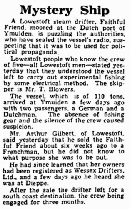
Daily Mail 14th April 1938
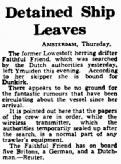
Daily Mail 15th April 1938
Thanks to Martin van der Ven for information and material about Sender der Deutsche Freiheitsparte




Ground
Floor
Back to




State Monopolies and International Agreements









Back to Gallery index

Early Offshore Days (3)

Click images to enlarge

Broadcasting Magazine
15th July 1933
